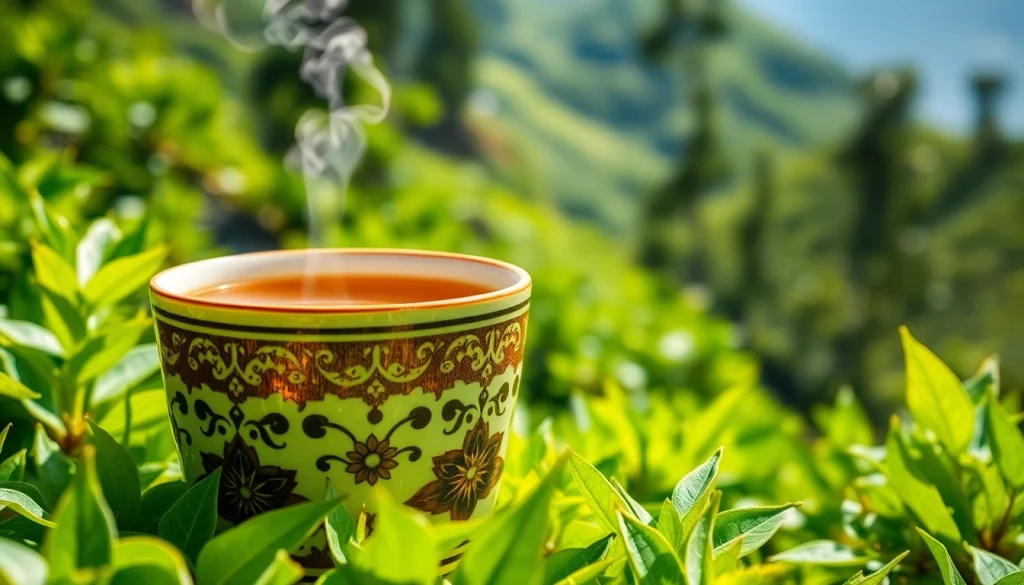Understanding Nepali Tea: Rich Flavors and Unique Varieties from the Himalayas

What is Nepali Tea?
Nepali tea is a delightful beverage derived from the leaves of tea plants (Camellia sinensis) cultivated in the verdant highlands of Nepal. This unique tea has garnered attention for its distinctive flavors and aroma, drawing comparisons to the renowned Darjeeling tea. Gaining popularity in international markets, Nepali tea is celebrated not just for its taste but also for its cultural significance within Nepalese society.
Characteristics of Nepali Tea
The allure of Nepali tea lies in its multifaceted characteristics. Its flavor profile ranges from floral to muscatel, with many varieties showcasing a distinct sweetness balanced by a gentle astringency. The tea is often characterized by a vibrant golden or amber hue, indicating its rich and robust nature. Nepali tea plants benefit from the high elevations and unique climatic conditions of the Himalayas, which contribute to the development of these complex flavor profiles.
Moreover, Nepali tea is known for its fresh aroma, often described as having hints of earthiness and sweetness. The tea is typically hand-harvested and minimally processed, preserving its natural essence and ensuring a high-quality product. This artisanal approach greatly distinguishes it from mass-produced varieties available in global markets.
Cultural Significance of Nepali Tea
In Nepal, tea is not just a drink but an integral part of the social fabric. It is common to greet guests with a cup of hot tea, a gesture of hospitality deeply rooted in tradition. The ritual of sharing tea binds families and communities together, and it holds a ceremonial role in many rituals and celebrations. Many Nepalese people enjoy the beverage throughout the day, often blending it with spices, milk, and sugar to create a hearty brew known as “Chiyaa.”
The significance of tea in Nepali culture extends beyond everyday enjoyment; it has also become a source of livelihood for many farmers in regions such as Ilam and Dhankuta. The cultivation and production of Nepali tea have provided sustainable economic opportunities while promoting local craftsmanship.
Overview of Tea Regions in Nepal
Nepal is home to several renowned tea-growing regions, each contributing unique flavors and characteristics to its teas. The major tea-growing areas include:
- Ilam: Located in eastern Nepal, Ilam is famous for producing high-quality tea known for its mild flavor and aromatic infusions. The unique terroir, characterized by its altitude and climate, yields some of the best black teas reminiscent of Darjeeling.
- Dhankuta: Another prominent tea-producing region, Dhankuta, is known for its artisanal teas that often showcase a deeper muscatel flavor. The steep slopes and rich soil of Dhankuta create ideal growing conditions.
- Makwanpur: Less widely known but gradually gaining recognition, this region has begun to produce excellent quality teas that offer nuanced flavors, appealing to a broad audience.
Each region’s unique climate, altitude, and farming practices contribute to the diverse offerings of Nepali tea, ensuring that there’s something for everyone.
Types of Nepali Tea Varieties
The diversity of Nepali tea extends beyond its cultivation regions to its various types and styles. From robust black teas to delicate green teas, Nepali offerings are extensive and cater to different palates. Below are the primary types of Nepali tea varieties.
Black Tea: Flavorful Brews
Nepali black tea is one of the most celebrated exports, renowned for its rich, bold flavors. Often compared to Darjeeling tea, Nepali black tea exhibits complex flavor profiles that can range from fruity to floral, and earthy to sweet. The first flush teas, harvested in spring, are particularly prized for their light body and muscatel notes, while the second flush offers a stronger infusion and a richer taste.
Some popular varieties include:
- Ilam Black Tea: Known for its soft and smooth profile, it features sweet, aromatic notes that are appealing to both beginners and seasoned tea lovers.
- Panchthar Black Tea: Unique in its production style, this tea displays a robust flavor combined with floral undertones, making it a favorite among connoisseurs.
- Dhankuta Black Tea: Offering a malty taste, this black tea stands out for its complexity and is often enjoyed plain or with a splash of milk.
Green Tea: Fresh and Aromatic
The green teas from Nepal have gained significant acclaim for their refreshing and fragrant characteristics. These teas showcase a grassy sweetness and come with various health benefits, making them popular among health-conscious consumers.
Notable varieties include:
- Nepali Green Tea: Harvested from younger leaves, this tea is processed quickly to retain its fresh flavors. It boasts a subtle taste with hints of nuttiness.
- Himalayan Green Tea: Grown in the higher altitudes, this green tea exhibits a smooth texture and a sweet finish, appealing to those who favor lighter teas.
Herbal and Specialty Teas
Beyond the traditional black and green teas, Nepal also produces a range of herbal and specialty teas. These varieties often incorporate local herbs and spices, creating unique blends that cater to various tastes and preferences.
Some examples include:
- Ginger Tea: A warming infusion, ginger tea is perfect for colder days and is known for its calming properties.
- Himalayan Mint Tea: Combining the refreshing taste of mint with other local herbs, this tea provides a delightful and invigorating experience.
Health Benefits of Nepali Tea
In addition to its delightful flavors, Nepali tea is also lauded for its numerous health benefits. Packed with antioxidants and essential compounds, regular consumption of Nepali tea can be a nourishing addition to your diet.
Rich in Antioxidants
Nepali tea, particularly the green and black varieties, is rich in antioxidants such as catechins and polyphenols. These compounds play a vital role in neutralizing free radicals in the body, reducing oxidative stress, and potentially lowering the risk of chronic diseases, including heart disease and cancer. Regularly consuming these teas promotes overall health and wellness.
Boosting Mental Clarity
With its moderate caffeine content, Nepali tea helps enhance alertness and improve focus. The combination of caffeine and the amino acid L-theanine found in tea provides a smooth energy boost, enhancing cognitive function without the jitters often associated with coffee. Drinking a cup of Nepali tea can be an excellent way to sharpen your mind and devote your full attention to tasks.
Improving Digestive Health
Nepali tea may also contribute positively to digestive health. The polyphenols in tea can help regulate gut bacteria, promoting a healthy digestive system. Additionally, herbal varieties, especially those infused with spices like ginger and mint, are commonly used to soothe digestive discomfort.
How to Brew the Perfect Cup of Nepali Tea
Brewing the perfect cup of Nepali tea is both an art and a science. The freshness of the leaves, the right temperature, and steeping time contribute significantly to the flavor and aroma of the tea.
Choosing Quality Nepali Tea Leaves
The journey to the perfect cup begins with selecting high-quality tea leaves. Look for whole leaves rather than broken fragments, as these retain more flavor and essential oils. Sourcing tea from reputable producers in regions like Ilam or Dhankuta ensures you get the best possible quality. Many online retailers provide samples, allowing you to explore different varieties before purchasing.
Steps for Brewing
To brew a delightful cup of Nepali tea, follow these steps:
- Measure the Tea: Use about one teaspoon of loose-leaf tea per cup of water.
- Heat the Water: The water temperature varies with tea type; generally, black tea requires boiling water (around 200°F or 93°C) while green tea should be prepared with slightly cooler water (about 175°F or 80°C).
- Steep the Tea: Let the tea steep for 3-5 minutes for black and 2-3 minutes for green tea. Adjust steeping times based on personal taste preferences.
- Strain and Serve: Use a fine mesh strainer to separate the tea leaves from the liquid. Enjoy your tea plain, or enhance the flavor with milk, honey, or lemon as desired.
Pairing Nepali Tea with Food
Pairing food with Nepali tea can elevate both the meal and tea experience. Here are some delightful pairings:
- Black Tea: Pairs well with savory snacks such as samosas, pastries, or sandwiches due to its robust flavor.
- Green Tea: Complements light dishes and salads, enhancing their freshness without overpowering them.
- Herbal Teas: Herbal infusions go beautifully with desserts and sweet treats, balancing sweetness with their herbal notes.
Where to Purchase Authentic Nepali Tea
Finding authentic Nepali tea can enhance your enjoyment and appreciation of this unique beverage. Here are some tips and recommendations for sourcing high-quality Nepali tea.
Top Online Retailers of Nepali Tea
Several reputable online retailers offer a range of Nepali teas. For the best selection, look for dedicated tea companies that specialize in artisanal teas sourced directly from Nepal. Many of these retailers often provide detailed descriptions of their products, allowing consumers to make informed choices.
Local Shops and Tea Houses
In addition to online shopping, consider exploring local tea shops and specialty stores that focus on international and artisanal teas. Many Asian markets may offer a curated selection of Nepali teas, allowing you to discover unique flavors and blends.
Understanding Fair Trade Practices
When purchasing Nepali tea, consider supporting producers who adhere to fair trade principles. Fair trade practices ensure that farmers receive fair compensation for their labor, fostering sustainable farming practices and enhancing local communities. Look for certifications or partnerships that highlight the commitment to ethical sourcing.
In conclusion, Nepali tea represents a perfect blend of culture, tradition, and health benefits encapsulated in each cup. With its diverse varieties and rich heritage, it is a testament to the artistry of tea cultivation in the heart of the Himalayas. Whether you are a seasoned tea enthusiast or a curious newcomer, exploring the world of Nepali tea promises to be an enriching experience.






